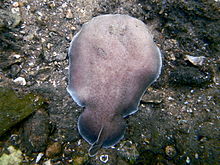Coffin ray
| Coffin ray | |
|---|---|

| |
| Scientific classification | |
| Domain: | Eukaryota |
| Kingdom: | Animalia |
| Phylum: | Chordata |
| Class: | Chondrichthyes |
| Subclass: | Elasmobranchii |
| Superorder: | Batoidea |
| Order: | Torpediniformes |
| Family: | Hypnidae T. N. Gill , 1862
|
| Genus: | Hypnos A. H. A. Duméril , 1852
|
| Species: | H. monopterygius
|
| Binomial name | |
| Hypnos monopterygius (G. Shaw, 1795)
| |

| |
| Range of the coffin ray[1] | |
| Synonyms | |
|
Hypnos subnigrum Duméril, 1852 | |
Hypnos monopterygius, also known as the coffin ray or Australian numbfish, is a
The sluggish and
Taxonomy and phylogeny
The first scientific reference to the coffin ray was written by English
The common name "coffin ray" comes from the
Distribution and habitat
The coffin ray has a wide but
Description

The unusual pear-like shape of the coffin ray distinguishes it from all other rays. Its body is flabby, with two large, kidney-shaped
The
Biology and ecology

The coffin ray is a slow and weak swimmer that moves forward with a jerky, fluttery motion. It is
The diet of the coffin ray consists mostly of
They are preyed upon by tiger sharks. One large tiger shark caught at Port Stephens in the early 20th century had more than thirty of them in its stomach.[8]
Human interactions
When approached, the coffin ray tends to keep still in its place of concealment on the
In 1883,
References
- ^ . Retrieved 12 November 2021.
- ^ Shaw, G. & Nodder, F.P. (1789–1813). The Naturalist's Miscellany. Plates 202–203.
- ^ Duméril, A.H.A. (1852). "Monographie de la famille des torpédiniens, ou poissons plagiostomes électriques, comprenant la description d'un genre nouveau, de 3 espèces nouvelles, et de 2 espèces nommées dans le Musée de Paris, mais non encore décrites". Revue et Magasin de Zoologie. (Sér. 2). 4: 176–189, 227–244, 270–285.
- ^ a b Bigelow, H.B.; Schroeder, W.C. (1953). Fishes of the Western North Atlantic, Part 2. Sears Foundation for Marine Research, Yale University. pp. 80–96.
- ^ ISBN 978-0-674-03411-2.
- ^ a b c Froese, Rainer; Pauly, Daniel (eds.) (2015). "Hypnos monopterygius" in FishBase. April 2015 version.
- ISBN 0-8493-1514-X.
- ^ a b "THE NUMB-FISH". Telegraph (Brisbane, Qld. : 1872 - 1947). 10 April 1937. p. 20. Retrieved 17 July 2021.
- ^ ISBN 92-5-104302-7.
- ^ ISBN 0-930118-18-9.
- ^ Bray, D.J. (2011): Coffin Ray, Hypnos monopterygius, in Fishes of Australia, http://www.fishesofaustralia.net.au/home/species/1843 Archived 11 May 2013 at the Wayback Machine
- ^ a b Murch, A. Coffin Ray. Elasmodiver.com.
- ^ a b McGrouther, M. (2011): Numbfish, Hypnos monopterygium (Shaw & Nodder 1795). Australian Museum.
- doi:10.1071/IT01004.
- ^ Beveridge, I.; Sakanari, J.A. (1987). "Lacistorhynchus dollfusi sp. nov.(Cestoda: Trypanorhyncha) in elasmobranch fishes from Australian and North American coastal waters". Transactions of the Royal Society of South Australia. 111 (3–4): 147–154.
- ^ Beveridge, I. (1987). "Echinocephalus overstreeti Deardorff & Ko, 1983 (Nematoda: Gnathostomatoidea) from elasmobranchs and molluscs in South Australia". Transactions of the Royal Society of South Australia. 3 (1–2): 79–92.
- ^ a b "Seascraps NUMB-FISH". Queensland Times (Ipswich, Qld. : 1909 - 1954). 22 May 1953. p. 6. Retrieved 17 July 2021.
- ^ "THE TORPEDO OR NUMB FISH". Evening News (Sydney, NSW : 1869 - 1931). 13 May 1905. p. 9. Retrieved 17 July 2021.
- ^ Ramsay, E.P. (1883). Notes on the food fishes and edible mollusca of New South Wales, etc., etc., exhibited in the New South Wales Court. W. Clowes and Sons. p. 33.

